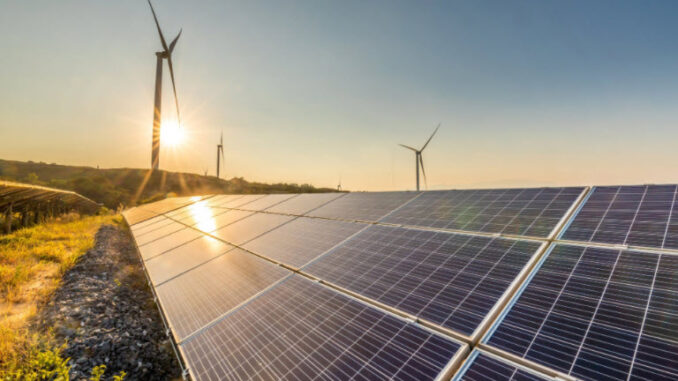
The recipe for renewable energy’s 2020 breakout was so perfect it deserves a Michelin star. Technological improvements had been simmering for years and paired perfectly with short-term seasonings like low interest rates. The result was a 234% surge in the Invesco Solar ETF (NYSEMKT:TAN), a 59% increase in the First Trust Global Wind Energy ETF (NYSEMKT:FAN), and tons of excitement surrounding electric vehicle (EV) and hydrogen fuel cell companies. And then seemingly out of nowhere, the narrative shifted.
In the last month alone, the average stock in the previously mentioned solar and wind ETFs is down 24% and 16%, respectively. Many smaller names are down over 50%. Meanwhile, the broader energy sector is up 24%. Here’s why renewable energy stocks are crashing, and the actions you can take to navigate the volatility.
A different narrative
To understand why Wall Street has suddenly turned sour on renewables, we need to determine what has changed between last year and this year. Summed up in the table below are five short- and medium-term factors that have gone from tailwinds to headwinds. Next, we’ll break down each of these factors in more detail.
| Factor | 2020 | 2021 | Consequence |
|---|---|---|---|
| Interest rates | Falling interest rates | Rising interest rates | Debt is more expensive, which makes it harder to grow. |
| Earnings expectations | Renewable companies had low to moderate growth | Growth may not return to pre-pandemic levels this year | During a recession, low to moderate growth looks like resilience. During an economic expansion, high growth is expected. |
| Oil and gas prices | Oil and gas prices plummeted | Oil and gas prices are higher than before the pandemic | Oil and gas companies quickly went from out of favor to in favor, weakening the case for renewable energy in the short term. |
| Competition | Divestment away from fossil fuels into renewables | Saturated supply and higher competition | Potentially lower profit margins |
| Valuation | Investor optimism | Valuation concerns | Stock prices fall |
1. Interest rates
There are few things that can stimulate an economy more than low interest rates. For consumers like you and me, low interest rates can make seemingly unaffordable things affordable, like new homes, cars, and other goods and services. Businesses benefit in the same way by gaining access to capital that allows them to make investments, hire employees, and pursue projects. Rising interest rates have the opposite effect. As debt becomes more expensive, the rate of return for a renewable project decreases — resulting in fewer developments and lower growth.
10 YEAR TREASURY RATE DATA BY YCHARTS
2. Earnings expectations
2020 was a period of slowing growth for most renewable companies. On its own, this isn’t great news. But in the context of a pandemic, it looks like recession resilience. The vast majority of energy and industrial companies had lower revenue and profit last year than in 2019 while many renewables were able to improve their top and bottom lines. For example, leading solar components manufacturers SolarEdge (NASDAQ:SEDG) and Enphase Energy (NASDAQ:ENPH) were able to sustain fairly high profit margins, maintain or increase spending, and grow revenue.
With the economy reopening, many pandemic underperformers are expected to stage big comebacks whereas companies like SolarEdge are expecting first-quarter revenue to be 8% lower than last year. Slow to moderate growth, let alone negative growth, looks bad when the overall economy is improving.
3. Oil and gas is now in favor
In 2020, low commodity prices brought oil and gas companies to their knees, forcing them to slash spending, cut dividends, take on tons of debt, record writedowns, and report some of the largest annual losses in history. But now, West Texas Intermediate (WTI) oil prices, the commonly quoted U.S. benchmark, are at their highest point in over a year. Prices averaged less than $40 per barrel in 2020. Today, WTI is over $65 per barrel. Even less well run oil companies can turn a profit at $65 oil. For the ones that have made timely acquisitions and lowered their production costs, $65 oil is like waking up every morning and winning the lottery.
4. Competition
Several years of divesting away from fossil fuels toward renewables reached a tipping point last year. Utilities that mostly relied on natural gas, nuclear energy, and coal made big investments into renewables. Fed up with negative public sentiment and multi-billion dollar losses, many of the largest oil majors in the world announced aggressive and detailed plans to transition toward renewable energy. Widespread renewable investment was seen as a sign of strength. But now, companies are beginning to realize that the industry just got a lot more competitive, which could impact profitability even for established players.
5. Valuation
With everything going right, renewable stocks were the investment of choice in 2020. Today, the factors discussed make them look less attractive in the short term, especially compared to oil and gas. Companies whose stocks doubled or tripled last year suddenly look overvalued.
Long-term trends remain intact
Very real short-term threats are affecting renewables. But these risks shouldn’t be confused with the long-term narrative, which remains brighter than ever. In many cases, new onshore wind and solar projects can generate power for a cheaper price than fossil fuels — even without subsidies. Advancements in hydrogen and energy storage are adding much-needed reliability to the grid. Countries and companies around the world have adopted aggressive carbon-reduction goals that depend on renewable energy. The U.S. has reentered the Paris Agreement and the Biden administration is focused on climate change. And just last week, the U.N. secretary-general announced that coal needs to be completely phased out of developed and developing countries. Add it all up, and there’s a good chance that renewables, not fossil fuels, will become the world’s dominant source of energy in the coming decades.

Source: The Motley Fool
Should you invest $1,000 in Invesco Exchange-Traded Fund Trust II – Invesco Solar ETF right now?
Before you consider Invesco Exchange-Traded Fund Trust II – Invesco Solar ETF, you’ll want to hear this.
Investing legends and Motley Fool Co-founders David and Tom Gardner just revealed what they believe are the 10 best stocks for investors to buy right now… and Invesco Exchange-Traded Fund Trust II – Invesco Solar ETF wasn’t one of them.
The online investing service they’ve run for nearly two decades, Motley Fool Stock Advisor, has beaten the stock market by over 4X.* And right now, they think there are 10 stocks that are better buys.






1 Trackback / Pingback
Comments are closed.